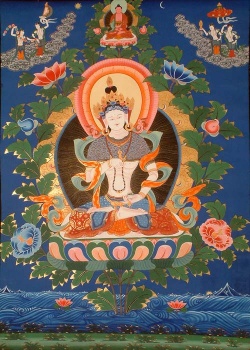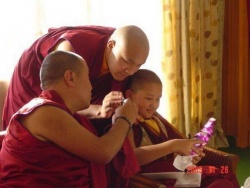Difference between revisions of "How do I become a Buddhist"
(Created page with "<poem> The formal process of declaring oneself a Buddhist is traditionally referred to as " Taking Refuge in the Triple Gem." The Triple Gem, also referred to ...") |
|||
| Line 1: | Line 1: | ||
| + | [[File:0606.jpg|thumb|250px|]] | ||
<poem> | <poem> | ||
The formal process of declaring oneself a [[Buddhist]] is [[traditionally]] referred to as " [[Taking Refuge in the Triple Gem]]." The [[Triple Gem]], also referred to as The [[Three Jewels]], consists of: the [[Buddha]]; the one who became [[enlightened]]; the [[Dharma]], or the teachings of the [[Buddha]]; and the [[Sangha]], or those who have made a committed [[effort]] to follow these teachings in their daily [[lives]]. So to "take [[refuge]]" means that you have found within the [[Buddha]], [[Dharma]] and [[Sangha]], the [[teacher]], teachings, and the community of {{Wiki|learning}} and practice that is appropriate for you in your [[spiritual]] journey in life. | The formal process of declaring oneself a [[Buddhist]] is [[traditionally]] referred to as " [[Taking Refuge in the Triple Gem]]." The [[Triple Gem]], also referred to as The [[Three Jewels]], consists of: the [[Buddha]]; the one who became [[enlightened]]; the [[Dharma]], or the teachings of the [[Buddha]]; and the [[Sangha]], or those who have made a committed [[effort]] to follow these teachings in their daily [[lives]]. So to "take [[refuge]]" means that you have found within the [[Buddha]], [[Dharma]] and [[Sangha]], the [[teacher]], teachings, and the community of {{Wiki|learning}} and practice that is appropriate for you in your [[spiritual]] journey in life. | ||
| Line 5: | Line 6: | ||
Basic [[Buddha's]] Teaching | Basic [[Buddha's]] Teaching | ||
| + | [[File:10-tumo2-450.jpg|thumb|250px|]] | ||
| + | - It is a way of [[life]], evolving between ourselves and the universe | ||
| + | - A [[teacher]] and student relationship | ||
| + | - To develop greater [[love]] and understanding through the practice of restraint, mindfulness/concentration. Our own [[self]] nature is one of great [[love]] and understanding it is just temporarily covered by our bad [[habits]] of [[greed]], [[anger]] and [[delusion]]. We need to reveal or return to our true self's again, the '[[Buddha]] within' by cultivating and practicing the three fundamental teachings of restraint ([[sila]]), [[concentration]]/ stable mindedness ([[samadhi]]), understanding (prajna) | ||
| + | - Basically to abstain from all bad and cultivate all good and purify our own minds | ||
| − | + | Bowing to the [[Buddha]] | |
| − | |||
| − | |||
| − | |||
| − | |||
| − | |||
| − | - Showing the students' [[respect]] to the great teacher. | + | - Showing the students' [[respect]] to the great teacher. |
| − | - Cultivating [[mindfulness]] of your [[bodily]] [[action]]. Trains the [[mind]] to be attentive. | + | - Cultivating [[mindfulness]] of your [[bodily]] [[action]]. Trains the [[mind]] to be attentive. |
| − | - Helps to get rid of one's [[arrogance]] and cultivate humbleness. | + | - Helps to get rid of one's [[arrogance]] and cultivate humbleness. |
| − | - Putting palms together reminds the learner to maintain [[one-pointedness]] of mind. | + | - Putting palms together reminds the learner to maintain [[one-pointedness]] of mind. |
| − | Buddha Statues | + | [[Buddha]] Statues |
| − | + | [[File:419242 n.jpg|thumb|250px|]] | |
| − | - Reminds us of our [[teacher]] Sakyamoni [[Buddha]] and therefore reminds us of his great teaching. | + | - Reminds us of our [[teacher]] Sakyamoni [[Buddha]] and therefore reminds us of his great teaching. |
| − | - Reflection of our own [[Buddha nature]]. When we bow to the [[Buddha]] we are turning back to our own [[self]] nature/ [[Buddha]] nature. | + | - Reflection of our own [[Buddha nature]]. When we bow to the [[Buddha]] we are turning back to our own [[self]] nature/ [[Buddha]] nature. |
| − | - An Artistic [[representation]] of the [[Buddha's]] [[compassionate]] and serene charisma. | + | - An Artistic [[representation]] of the [[Buddha's]] [[compassionate]] and serene charisma. |
| − | - More [[information]] on [[Buddha]] Statues | + | - More [[information]] on [[Buddha]] Statues |
Buddha Shrine | Buddha Shrine | ||
| − | - A [[teaching]] hall. | + | - A [[teaching]] hall. |
| − | - A place for group cultivation and [[Dharma]] talk. | + | - A place for group cultivation and [[Dharma]] talk. |
| − | - Used for mediation practice. | + | - Used for [[mediation]] practice. |
| − | - A Museum of [[Buddhist]] Artworks. | + | - A Museum of [[Buddhist]] Artworks. |
Chanting | Chanting | ||
| − | - A way to memorize the [[Buddha's]] teaching. | + | - A way to memorize the [[Buddha's]] teaching. |
| − | - When recited regularly they help to remind us of the teachings. | + | - When recited regularly they help to remind us of the teachings. |
| − | - Develops our [[concentration]] and [[peacefulness]] which in turn develops our [[wisdom]] and understanding. | + | - Develops our [[concentration]] and [[peacefulness]] which in turn develops our [[wisdom]] and understanding. |
| − | - Has the same effect of [[meditation]] and reciting the [[Buddha's]] [[name]]. The only [[difference]] is [[the object]] of [[concentration]]r [[meditation]] it's the [[breath]], for [[sutra]] recitation it's the [[Buddha's]] words and for [[name]] recitation, it's the [[Buddha's]] [[name]]. Its a matter of which cultivation you [[feel]] more comfortable with. | + | - Has the same effect of [[meditation]] and reciting the [[Buddha's]] [[name]]. The only [[difference]] is [[the object]] of [[concentration]]r [[meditation]] it's the [[breath]], for [[sutra]] recitation it's the [[Buddha's]] words and for [[name]] recitation, it's the [[Buddha's]] [[name]]. Its a matter of which cultivation you [[feel]] more comfortable with. |
The Robes | The Robes | ||
| − | Lay disciple's black robe: | + | Lay [[disciple]]'s black robe: |
| − | - worn by [[Buddhist]] lay students. | + | |
| − | - A way of showing group cohesion and [[harmony]]. Not unlike the uniform in a school. | + | - worn by [[Buddhist]] lay students. |
| − | - worn during ceremonies and for Chanting. | + | - A way of showing group cohesion and [[harmony]]. Not unlike the uniform in a school. |
| + | - worn during ceremonies and for Chanting. | ||
| + | |||
Lay disciple's brown [[precept]] robe: | Lay disciple's brown [[precept]] robe: | ||
| − | - worn during [[Chanting]] and ceremonies. | + | |
| − | - worn only after taking the [[five precepts]] or the | + | - worn during [[Chanting]] and ceremonies. |
| − | - worn by [[Buddhist]] lay students. | + | - worn only after taking the [[five precepts]] or the [[Bodhisattva]] precepts. |
| − | - Have the effect of reminding the students of their commitment to [[self]] improvement through following the [[Buddha's]] guidelines of basic [[human]] [[morality]]. | + | - worn by [[Buddhist]] lay students. |
| + | - Have the effect of reminding the students of their commitment to [[self]] improvement through following the [[Buddha's]] guidelines of basic [[human]] [[morality]]. | ||
</poem> | </poem> | ||
{{R}} | {{R}} | ||
[http://www.bliav.org.au/dharma/basic1.html#1 www.bliav.org.au] | [http://www.bliav.org.au/dharma/basic1.html#1 www.bliav.org.au] | ||
[[Category:Sangha]] | [[Category:Sangha]] | ||
| + | [[Category:Chinese Buddhism]] | ||
Revision as of 09:42, 7 September 2013
The formal process of declaring oneself a Buddhist is traditionally referred to as " Taking Refuge in the Triple Gem." The Triple Gem, also referred to as The Three Jewels, consists of: the Buddha; the one who became enlightened; the Dharma, or the teachings of the Buddha; and the Sangha, or those who have made a committed effort to follow these teachings in their daily lives. So to "take refuge" means that you have found within the Buddha, Dharma and Sangha, the teacher, teachings, and the community of learning and practice that is appropriate for you in your spiritual journey in life.
There are no preparatory classes that must be taken but it is best to learn as much as you can about Buddhism and what it will mean in your life. One should not come to a hasty conclusion either by judging the validity of a religion or by condemning the religion simply by observing what people perform through their blind faith in the name of that religion. To understand the real nature of a religion one must study and investigate the original teachings of the founder of that religion.
If you wish to officially become a Buddhist, you must contact one of the Venerables and let them know your wishes. They will make arrangements for you to Take Refuge and/or take the Five Precepts.
Basic Buddha's Teaching
- It is a way of life, evolving between ourselves and the universe
- A teacher and student relationship
- To develop greater love and understanding through the practice of restraint, mindfulness/concentration. Our own self nature is one of great love and understanding it is just temporarily covered by our bad habits of greed, anger and delusion. We need to reveal or return to our true self's again, the 'Buddha within' by cultivating and practicing the three fundamental teachings of restraint (sila), concentration/ stable mindedness (samadhi), understanding (prajna)
- Basically to abstain from all bad and cultivate all good and purify our own minds
Bowing to the Buddha
- Showing the students' respect to the great teacher.
- Cultivating mindfulness of your bodily action. Trains the mind to be attentive.
- Helps to get rid of one's arrogance and cultivate humbleness.
- Putting palms together reminds the learner to maintain one-pointedness of mind.
Buddha Statues
- Reminds us of our teacher Sakyamoni Buddha and therefore reminds us of his great teaching.
- Reflection of our own Buddha nature. When we bow to the Buddha we are turning back to our own self nature/ Buddha nature.
- An Artistic representation of the Buddha's compassionate and serene charisma.
- More information on Buddha Statues
Buddha Shrine
- A teaching hall.
- A place for group cultivation and Dharma talk.
- Used for mediation practice.
- A Museum of Buddhist Artworks.
Chanting
- A way to memorize the Buddha's teaching.
- When recited regularly they help to remind us of the teachings.
- Develops our concentration and peacefulness which in turn develops our wisdom and understanding.
- Has the same effect of meditation and reciting the Buddha's name. The only difference is the object of concentrationr meditation it's the breath, for sutra recitation it's the Buddha's words and for name recitation, it's the Buddha's name. Its a matter of which cultivation you feel more comfortable with.
The Robes
Lay disciple's black robe:
- worn by Buddhist lay students.
- A way of showing group cohesion and harmony. Not unlike the uniform in a school.
- worn during ceremonies and for Chanting.
Lay disciple's brown precept robe:
- worn during Chanting and ceremonies.
- worn only after taking the five precepts or the Bodhisattva precepts.
- worn by Buddhist lay students.
- Have the effect of reminding the students of their commitment to self improvement through following the Buddha's guidelines of basic human morality.


